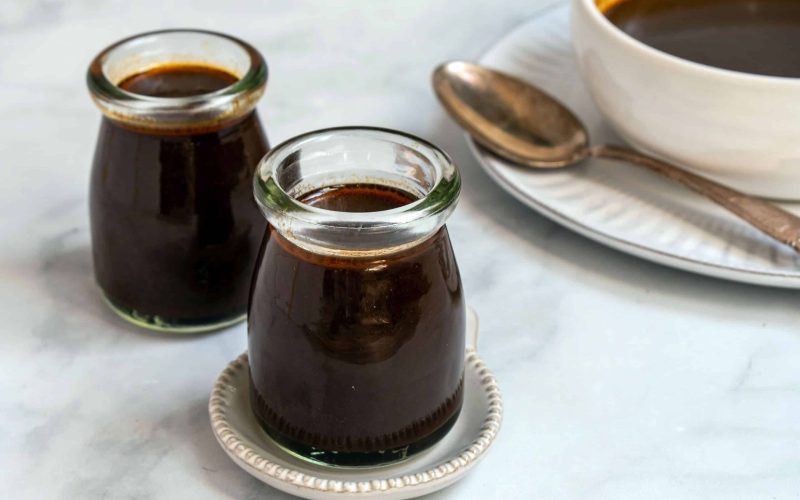Imagine your kitchen pantry without the trusty bottle of Worcestershire sauce.
This fermented condiment, which originated from Worcester, England, in the 18th century, blends vinegar, molasses, sugar, anchovies, cloves, onion, garlic, and chili pepper extract to create a symphony of tangy, umami flavors.
It’s a go-to ingredient for chefs like Alex Guarnaschelli and Jamie Oliver to elevate dishes from Brussels sprouts to shepherd’s pie.
When Worcestershire sauce is missing, your savory dishes lose that flavorful punch.
Its combination of vinegar, garlic, and spices can transform everything from soups and stews to meats and cocktails.
Whether you’re preparing meatballs for a tailgate or want to try a new taste, understanding the best substitutes for Worcestershire sauce will help you maintain that delicious, complex flavor profile in your culinary creations.
Balsamic Vinegar
Balsamic vinegar, made from unfermented grape juice, is one of the most versatile vinegars.
Its dark color comes from the grapes, and it offers a sweet yet acidic flavor.
This makes it an excellent substitute for Worcestershire sauce. To make a good replacement, combine equal parts balsamic vinegar and tamarind paste.
The tamarind pods contain a sticky pulp that’s often used in sauces, pastes, and juices.
When you mix the acidic sweetness of balsamic vinegar with the earthy, thick tamarind, you get a flavorful substitute for Worcestershire sauce.
Substitute Ideas:
- Balsamic Vinegar: Sweet and acidic, perfect for balancing flavors.
- Sherry Vinegar: Use when you want a nutty taste.
- Red Wine Vinegar: Ideal for bold and tangy dishes.
These options can enhance your recipes, adding depth and richness without losing the desired taste profile.
Soy Sauce
You likely have a bottle of soy sauce in your kitchen. Soy sauce is a mix of soybeans, wheat, water, and salt. Even though it doesn’t share many ingredients with Worcestershire sauce, it can be a good stand-in. Both sauces have a rich, dark color and a strong, fermented taste.
If you need to use soy sauce as a substitute, try adding freshly grated ginger. Simmer ¼ cup of water with the ginger, then mix it into the soy sauce. This adds a tangy, umami taste similar to Worcestershire. If you don’t like ginger, molasses can provide a similar effect.
Tamari, another type of soy sauce, can also be used. It’s usually gluten-free because it doesn’t contain wheat. Keep it handy if you’re cooking for someone with gluten sensitivities. Using soy sauce or tamari can easily add flavor to your dishes!
Fish Sauce
Fish sauce offers a rich umami flavor, often described as the “fifth taste.” This unique taste comes from a combination of fish and salt, fermented over several months. Commonly used in Thai and Vietnamese dishes, it provides a salty, briny punch that enhances various meals.
Both fish sauce and Worcestershire sauce contain anchovies, explaining their overlapping flavors. Fish sauce uses fermented anchovies, resulting in a potent, fishy taste. This fermentation process, lasting up to 12 months, draws out a concentrated liquid. This liquid is then bottled as the finished product. You can match fish sauce with an equal amount of Worcestershire sauce if you need a substitute.
In addition to being a stand-in for Worcestershire sauce, you can make a similar condiment by mixing fish sauce with lemon or lime juice. This mixture, known as “nam prik pla,” brings comparable flavor notes to your dishes.
Here’s a simple way to use fish sauce:
- Marinades: Add depth to meats and seafood.
- Dressings: Enhance salads with a hint of umami.
- Dipping Sauces: Create complex flavors for spring rolls or fried foods.
Marmite
If you need a substitute for Worcestershire sauce that captures similar salty and earthy flavors, try Marmite. This thick, dark brown spread originates from Britain and has a strong, concentrated taste made from brewer’s yeast extract and a hefty dose of salt. While Marmite may seem unusual for this purpose, it can work well in certain dishes due to its shared attributes with Worcestershire sauce.
Here’s why Marmite is a good alternative:
- Color: Marmite’s color closely matches Worcestershire sauce, making it visually suitable for many recipes.
- Flavor: Both Marmite and Worcestershire sauce have a salty, umami-rich profile, although Marmite is slightly sweeter.
- Usage: Because of Marmite’s intense flavor, use it sparingly. A small amount will suffice to provide the desired taste.
When using Marmite, spread it thinly if applying directly to food, like on toast. In cooking, incorporate it in small quantities, adjusting to taste gradually. This ensures the flavor enhances your dish without becoming overpowering. Despite its distinctiveness, Marmite can effectively bring depth and richness to your recipes when used thoughtfully.
Tamarind Concentrate
When you need a substitute for Worcestershire sauce, tamarind concentrate is a great option. This dark-brown pulp comes from tamarind tree pods and adds a sharp, fruity taste to dishes. While it might not be familiar to American cooks, it’s a staple in South Asian kitchens for sauces and pickles.
Types of Tamarind:
- Blocks of dried pulp: You need to rehydrate these before using.
- Jarred concentrate: More convenient, though some find it less flavorful.
Tamarind concentrate provides the sweet-sour flavor that Worcestershire sauce lovers will recognize.
Use tamarind concentrate in:
- Sauces: Enhances flavor with its fruity kick.
- Pickles: Adds a unique tang.
- Marinades: Brings out depth in meat dishes.
Why Choose Tamarind Concentrate?
- Convenience: Easy to find in stores and simple to use.
- Flavor: Replicates the distinct taste of Worcestershire.
Using tamarind concentrate can transform your recipes, bringing the delicious, complex flavors of South Asian cuisine into your home. Whether you’re making a sauce, a pickle, or a marinade, it offers an easy and flavorful option.
Pikkapeppa Sauce
Pikkapeppa sauce, a popular condiment from Jamaica, has found its way into many American Southern kitchens. This sauce is made with tomatoes, raisins, vinegar, mangoes, and spices, giving it a fruity and spicy flavor. The taste is quite similar to Worcestershire sauce, but with a twist of tropical flavors.
One of the standout ingredients in Pikkapeppa is mango, which adds a unique sweetness. This sweetness makes it thicker and a bit sweeter than Worcestershire sauce. This consistency and flavor profile make it perfect for pouring over a block of cream cheese for a quick and delicious party appetizer.
The origins of Pikkapeppa sauce trace back to 1921, when a Jamaican teenager experimenting in his family’s kitchen created it. Interestingly, the sauce developed independently of Worcestershire, even though they share many ingredients. The exact recipe remains a closely guarded secret.
Key Ingredients
- Tomatoes
- Raisins
- Vinegar
- Mangoes
- Spices
Enjoy using Pikkapeppa sauce as a delightful alternative to Worcestershire sauce, bringing a bit of tropical flair to your dishes.
A1/HP Sauce
If you need a substitute for Worcestershire sauce, A1 or HP sauce might be the answer. These sauces are common in many pantries and offer a similar tangy and fruity taste.
A1 and HP sauce both blend tomato, orange, and raisin pastes with vinegar. Their flavors also include garlic and onions, giving you that familiar sweet and tangy kick. These sauces resemble Worcestershire in their fruity and puckery qualities, making them perfect for your recipes.
Unlike Worcestershire, A1 and HP sauces are a bit thicker. This thickness doesn’t stop them from being great substitutes. You can use them in marinades, rich or meaty dishes, or even to add a unique touch to a Bloody Mary.
Ingredients that make A1 and HP sauce similar to Worcestershire:
- Tomato paste
- Orange paste
- Raisin paste
- Vinegar
- Garlic
- Onions
These traits help A1 and HP sauce mimic the taste of Worcestershire sauce, so they work well in various dishes. Your meals will still have that tangy and rich flavor you love.
Coconut aminos
Coconut aminos can serve as an excellent alternative in many recipes. This savory, thin, dark brown condiment is made from fermented coconut palm sap and salt. Despite its name, it doesn’t taste like coconut at all. Instead, it resembles soy sauce in both flavor and function, which makes it a versatile option in your kitchen.
When you need to add depth to your dishes, coconut aminos step in smoothly. They bring a salty profile with a touch of umami earthiness and a hint of sweetness. This combination creates a balance of flavors that can mimic the complexity of Worcestershire sauce. Additionally, coconut aminos have a mild tanginess similar to Worcestershire’s, allowing them to work as a one-to-one substitute.
Here are some common uses for coconut aminos:
- Soups
- Stews
- Stir-fries
- Marinades
- Dips
- Dressings
One of the biggest advantages of using coconut aminos is that they are gluten-free. If you are avoiding gluten for dietary reasons, these can be a great replacement for Worcestershire sauce.
Try incorporating them into your cooking, and you’ll see how they enhance the flavors of your favorite dishes without compromising on taste.
Maggi Seasoning
If you’ve ever spotted a bottle of dark brown liquid in the sauce aisle and passed it by, you might be missing out on a kitchen gem. Maggi seasoning plays a starring role in many kitchens worldwide. Made from fermented wheat, this seasoning has a deep, rich flavor profile that can make your dishes sing.
Imagine a flavor similar to soy sauce but enhanced with smoky, roasted undertones. That’s what Maggi brings to the table. Many cooks find that it enriches everything from hearty stews to delicate seafood. You can even splash a bit into your cocktails for a surprising twist.
Some say Maggi tastes a bit like Worcestershire sauce. But unlike Worcestershire, Maggi doesn’t have the same tangy sweetness. This makes it a handy Worcestershire sauce substitute when you want depth without extra sweetness.
Maggi’s flavor can vary by region, adding to its unique charm. The original version from Switzerland carries vegetable flavorings. Meanwhile, the Filipino variety offers a hint of garlic, and the Mexican version packs a sharper punch.
Whether you’re a cooking enthusiast or just looking to spice things up, Maggi seasoning might be what your pantry needs. Its versatile and complex flavor can help elevate your everyday meals to something special. So next time you’re wandering down the sauce aisle, consider grabbing a bottle and experimenting with this flavorful gem.
Oyster Sauce
Oyster sauce, a rich and salty-sweet condiment, offers a burst of flavor to many dishes. Rumor has it that a cook accidentally created it by leaving a pot of oyster soup on a burner overnight. The soup cooked down, caramelizing into the thick, dark brown sauce we know today. Despite its name, oyster sauce doesn’t taste like oysters. Instead, it provides a deep, meaty umami flavor similar to what anchovies bring to Worcestershire sauce.
If you’re in need of a Worcestershire substitute, oyster sauce works well. It’s made from a blend of oysters, sugar, salt, flour, cornstarch, and various flavorings. This combination cooks down to create a sauce that can be used in many recipes.
Here’s a quick glance at what oyster sauce adds:
- Texture: Thick and smooth.
- Taste: Salty-sweet with a deep umami flavor.
- Color: Dark brown
You’ll find oyster sauce particularly handy in stir-fries, marinades, and dipping sauces. It enhances the flavor without overpowering the other ingredients. So, next time you need a splash of umami, give oyster sauce a try.
Tonkatsu Sauce
Tonkatsu sauce brings a flavorful punch similar to Worcestershire sauce with its tangy, fruity, and umami notes, but it also adds a thicker and sweeter texture. Originally, Worcestershire sauce made its way to Japan in the 19th century, inspiring Japanese cooks to create their own version to pair with deep-fried, breaded cutlets of meat or chicken known as tonkatsu.
Key Ingredients in Tonkatsu Sauce:
- Worcestershire sauce: Adds a complex, tangy base.
- Ketchup: Brings sweetness and thickness.
- Oyster sauce: Enhances umami and richness.
Here’s a simple table comparing Tonkatsu sauce to its close relatives:
| Sauce Type | Flavor Profile | Best Used With |
|---|---|---|
| Tonkatsu Sauce | Tangy, fruity, umami, sweet | Breaded meat cutlets, fried dishes |
| Worcestershire Sauce | Tangy, umami, slightly spicy | Meat dishes, stews, sauces |
| BBQ Sauce | Sweet, smoky, tangy | Grilled meats, ribs, burgers |
If you don’t have tonkatsu sauce on hand, consider using BBQ sauce as an alternative. BBQ sauce offers a similar sweetness and smokiness that can work well in place of tonkatsu sauce.
Whether you’re a fan of Japanese cuisine or just in need of a versatile condiment, tonkatsu sauce is a great addition to your pantry. Experimenting with these sauces can elevate your dishes and add a unique twist to everyday meals.








